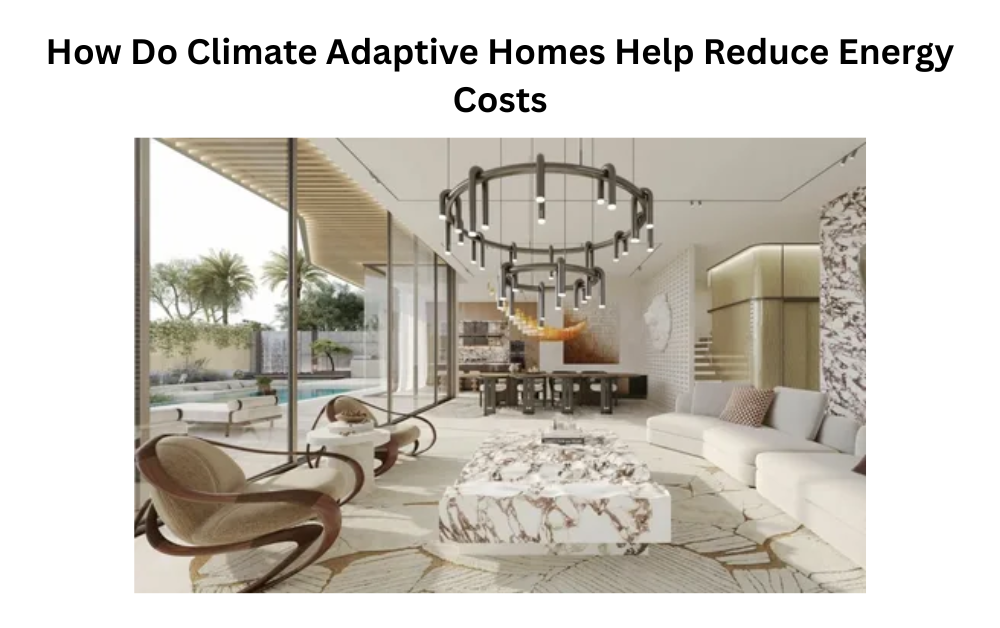How Do Climate Adaptive Homes Help Reduce Energy Costs

Introduction
Homes today are not just about shelter and comfort; they are also about being smart, sustainable, and cost-effective. One of the biggest concerns for homeowners is the rising cost of energy. Electricity bills, cooling systems, and heating requirements often take up a large part of household expenses. This is where climate adaptive homes come into the picture.
Climate adaptive homes are specially designed to work with the environment instead of fighting against it. They adjust to changing weather, reduce energy wastage, and create a balance between comfort and sustainability. By using modern designs, natural resources, and smart technologies, these homes can cut down monthly energy bills while also being eco-friendly.
Let us explore in detail how climate adaptive homes help reduce energy costs and why they are becoming the future of smart living.
Note: Climate Adaptive Homes in Dubai are smartly designed houses that adjust to the city’s hot climate, reduce energy use, lower electricity bills, and offer a sustainable and comfortable living experience.
Understanding Climate Adaptive Homes

Climate adaptive homes are not just about solar panels or energy-efficient bulbs. They go deeper into the structure, design, and functionality of the house. These homes are built to respond to weather patterns, sunlight, airflow, and temperature changes naturally.
-
They make use of natural light to reduce electricity use.
-
They improve ventilation to reduce the need for air conditioners.
-
They insulate the home properly to keep it cool in summer and warm in winter.
-
They use eco-friendly technology to lower power consumption.
The idea is simple: build a home that works in harmony with the climate around it, instead of relying too much on artificial systems.
How Climate Adaptive Homes Reduce Energy Costs
Using Natural Sunlight Effectively
One of the biggest sources of energy saving is the smart use of sunlight. Climate adaptive homes are designed with large windows, skylights, and glass panels that allow sunlight to enter during the day.
-
This reduces the need for artificial lighting.
-
Sunlight naturally warms the home in colder seasons.
-
Using daylight lowers electricity bills significantly.
A well-planned home can cut down lighting costs by more than half simply by using natural daylight.
Smart Ventilation and Airflow
Cooling systems like air conditioners consume a lot of power. But if a home is designed to allow natural airflow, the need for ACs is much lower.
-
Cross-ventilation allows fresh air to flow in and warm air to leave.
-
Roof designs and open spaces keep the home cool.
-
Using ventilated windows reduces humidity and improves comfort.
This not only lowers power bills but also improves indoor air quality.
Insulation and Heat Control
Another major way climate adaptive homes save energy is through insulation. Poorly insulated homes lose heat in winter and trap too much heat in summer, forcing people to spend more on heating and cooling systems.
-
Insulated walls, ceilings, and floors keep indoor temperatures stable.
-
Heat-reflective paints and coatings reduce unwanted heat.
-
Proper sealing prevents energy loss.
This means less use of heaters in winter and less use of air conditioners in summer.
Energy-Efficient Appliances and Smart Technology
Modern climate adaptive homes make use of energy-efficient appliances and smart technology.
-
LED lights consume less power.
-
Smart thermostats adjust temperatures automatically.
-
Energy-efficient fans, refrigerators, and water heaters save electricity.
These appliances are designed to consume less energy while still providing the same comfort.
Renewable Energy Systems
Many climate adaptive homes use renewable energy sources like solar panels and wind energy.
-
Solar panels generate electricity during the day, reducing dependency on the grid.
-
Solar water heaters cut down electricity bills for heating water.
-
Some homes use small wind turbines in windy areas.
These systems reduce long-term energy costs and make the home more self-sufficient.
Water Management and Energy Saving
Water systems also play a role in energy costs. Pumping, heating, and treating water requires electricity. Climate adaptive homes use smart water management systems such as:
-
Rainwater harvesting to reduce dependency on water supply.
-
Low-flow taps and showers to save water and reduce heating costs.
-
Greywater recycling for gardening and cleaning purposes.
This leads to both water savings and lower energy bills.
Additional Benefits of Climate Adaptive Homes
Long-Term Cost Savings
While climate adaptive homes may require a slightly higher investment initially, they pay back in the long run. Lower energy bills every month mean big savings over the years.
Healthier Living Environment
These homes use natural airflow, sunlight, and eco-friendly materials, which create a healthier indoor environment. Less use of artificial heating and cooling also reduces pollution inside the house.
Increased Property Value
As more people become aware of sustainable living, climate adaptive homes are gaining higher demand. Buyers are willing to pay more for homes that save energy and reduce costs.
Contribution to the Environment
Climate adaptive homes are not only about saving money. They also reduce carbon footprint, cut down pollution, and support a greener planet.
Practical Ways to Make Your Home Climate Adaptive
Smart Design and Orientation
The placement of the home plays a big role in energy efficiency.
-
Build windows in the direction of maximum sunlight.
-
Plant trees around the home for shade.
-
Use reflective materials on roofs.
Use of Eco-Friendly Building Materials
Materials like bamboo, recycled wood, and eco-friendly concrete reduce heat absorption and support sustainability.
Installing Solar Panels
Even a small set of solar panels can reduce dependency on electricity from the grid and lower bills.
Better Insulation and Window Glass
Use double-glass windows to reduce heat loss. Insulating materials in walls and ceilings will also lower heating and cooling costs.
Smart Home Technology
Smart home systems like automated lighting, thermostats, and energy monitoring apps help in managing electricity use better.
Common Myths About Climate Adaptive Homes
They Are Too Expensive
Many people think these homes are only for the wealthy. In reality, costs can be managed by choosing simple yet effective solutions like insulation, smart lighting, or ventilation improvements.
They Require High Maintenance
Climate adaptive homes are actually designed to reduce long-term costs and require less maintenance because they rely on natural systems.
They Compromise on Comfort
In fact, these homes increase comfort by keeping temperatures stable, reducing noise, and improving air quality.
Future of Climate Adaptive Homes
The demand for climate adaptive homes is increasing worldwide. With energy prices rising and environmental concerns growing, more people are realizing the importance of sustainable living. Governments and builders are also supporting eco-friendly housing projects with subsidies and tax benefits.
In the future, climate adaptive homes will become the standard way of living rather than just a trend. More innovations like smart glass, advanced solar panels, and artificial intelligence in home management will make them even more efficient.
Conclusion
Climate adaptive homes are a smart investment for anyone who wants to save money and live sustainably. By using natural resources, renewable energy, and smart design, these homes cut down energy costs without sacrificing comfort.
From natural sunlight to insulation, from solar panels to water management, every small feature plays a role in reducing electricity bills. The long-term benefits are clear—lower expenses, better health, higher property value, and a greener planet.
If you are planning to build or buy a home, choosing a climate adaptive design can be one of the wisest decisions. Not only will it help you save money every month, but it will also make your home future-ready in a world where energy conservation is becoming more important than ever.
DUR Real Estate L.L.C Leading real estate management company in Dubai offering expert property rental, investment consulting, and luxury property buying with full-service solutions.
For more insightful articles related to this topic, feel free to visit: mifinder.co
- Art
- Causes
- Crafts
- Dance
- Drinks
- Film
- Fitness
- Food
- Games
- Gardening
- Health
- Home
- Literature
- Music
- Networking
- Other
- Party
- Religion
- Shopping
- Sports
- Theater
- Wellness


